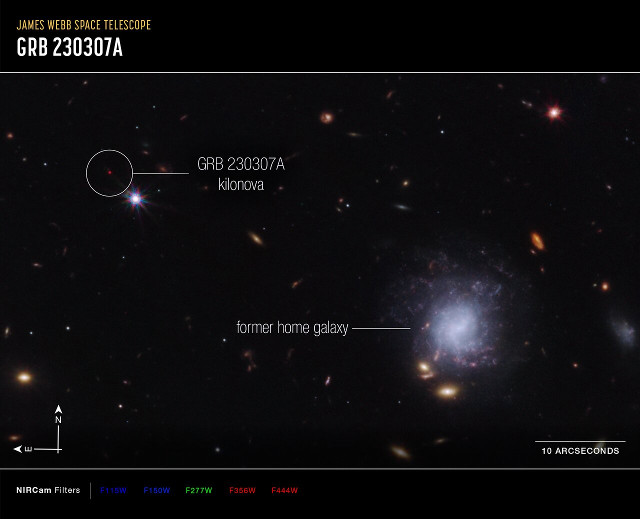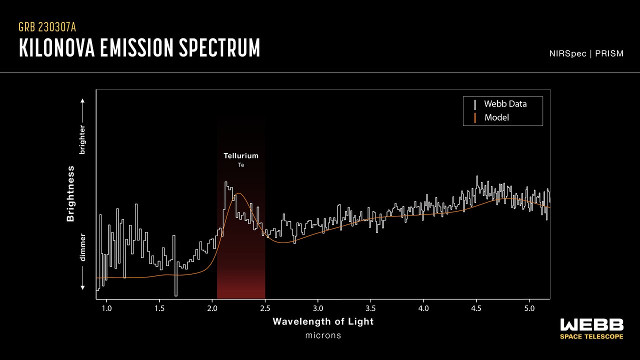
An article published in the journal “Nature” reports the detection of heavy elements including tellurium ejected from a kilonova, the merger between two neutron stars. A team of researchers started from the gamma-ray burst cataloged as GRB 230307A to examine data collected by ground-based and space telescopes which made it possible to identify the characteristics of a kilonova at the origin of that very powerful explosion, which lasted about 200 seconds in the second brightest gamma-ray burst detected so far.
The James Webb Space Telescope made it possible to examine the environment around the kilonova with its NIRCam and NIRSpec instruments, detecting the spectroscopic traces left in the emissions from materials ejected at high speed. For the first time, tellurium, a very rare element on Earth, was detected. Webb also made it possible to ascertain that the pair of neutron stars that merged was ejected from its home galaxy hundreds of millions of years ago.
The top image (NASA, ESA, CSA, STScI, A. Levan (IMAPP, Warw), A. Pagan (STScI)) shows the position of the kilonova that triggered the gamma-ray burst GRB 230307A and the home galaxy from where the progenitor stars arrived.
Many years after the kilonova concept was theorized, the gravitational wave event cataloged as GW170817 allowed a real one to be observed in an international collaboration that led to many observations in all electromagnetic bands. Kilonovae are rare but having examples that are useful to recognize them more easily is a great help and contributed to identifying one detected in recent months.
On March 7, 2023, NASA’s Fermi Space Telescope detected the gamma-ray burst GRB 230307A, extremely powerful even by the standards of these extraordinarily energetic explosions. The Swift space telescope, also a NASA instrument, was the second to detect that gamma-ray burst and the alarm that followed the discovery made it possible to conduct observations of that event and its consequences with other instruments in the various electromagnetic bands.
This amount of data led to the observation of the evolution of the event with a weak optical and infrared component compared to gamma rays and X-rays and a quick red shift due to the cooling of the materials. These are the characteristics of a kilonova. Astronomers thought that short gamma-ray bursts were emitted by kilonovae but GRB 230307A is definitely a long-duration gamma-ray burst.
The James Webb Space Telescope has the infrared sensitivity that provided crucial observations to identify the origin of the neutron stars that generated the kilonova. The intriguing discovery is that this pair were some sort of orphans that were likely ejected from a galaxy about 120,000 light-years away. The two progenitor stars exploded long ago, leaving two neutron stars and pushing the pair out of their home galaxy to travel hundreds of millions of years into intergalactic space.
The James Webb Space Telescope’s NIRCam (Near-Infrared Camera) and NIRSpec (Near-Infrared Spectrograph) instruments offered other very important information on the consequences of the kilonova in the form of spectroscopic emissions. They made it possible to find the traces left in the electromagnetic emissions by chemical elements ejected by the kilonova. There’s a spike of tellurium, an element that is rarer than platinum on Earth. The bottom image (NASA, ESA, CSA, J. Olmsted (STScI)) shows the spectral emissions detected by NIRSpec and the comparison between the detected tellurium peak and the one predicted by the theoretical model.
Kilonovae are considered the producers of various elements heavier than iron, and the detection of tellurium represents important evidence. The James Webb Space Telescope is precious for this type of research, and this is only its first detection of this kind. Astronomers are learning how to recognize kilonovae and use the most suitable instruments to study the evolution of a merger between neutron stars, understand whether a kilonova can also occur from the merger between a neutron star and a black hole, and detect other heavy elements produced, such as gold.


